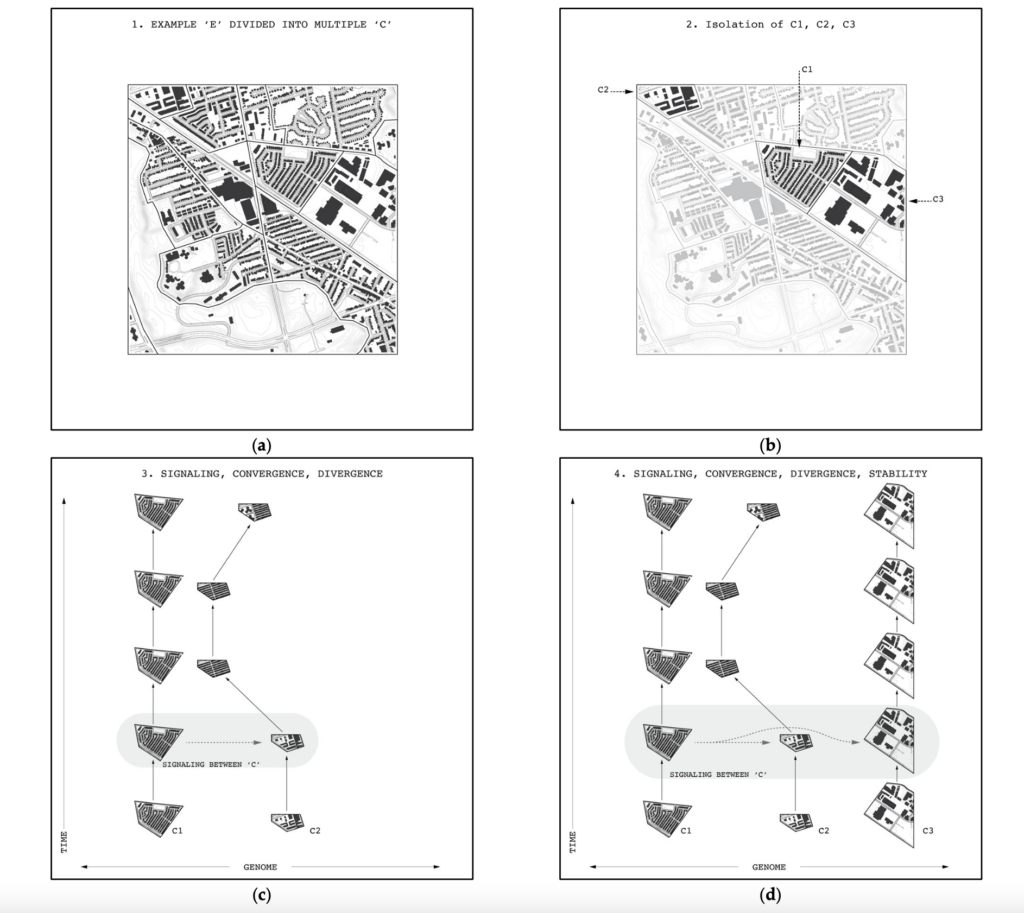A central theoretical goal of the Urban Genome Project has been to articulate a model of urban evolution. We develop the model in four papers, recently published together in Urban Science. The paper series is called “Towards a Model of Urban Evolution,” because its central task is to elaborate a rich yet rigorous formal language capable of formulating propositions about the evolution of cities.
Paper I is “Context.” It proceeds in four major sections. First, we review prior adumbrations of an evolutionary model in urban theory, noting their potential and their limitations. Examples include Chicago School Ecology, stage theories, and theories of cities as complex adaptive systems. Second, we turn to the general sociocultural evolution literature to draw inspiration for a fresh and more complete application of evolutionary theory to the study of urban life. Third, building upon this background, we outline the main elements of our proposed model, with special attention to elaborating the value of its key conceptual innovation, the “formeme”. A formeme is a specific encoding of urban space as a combination of physical features and the groups and activities toward which they are oriented.

In turn we discuss the value of the model, highlighting its extension of the basic inferential logic of population genetics and evolutionary ecology into the urban domain, including the goal of replacing essentialist with distributional thinking, group and development thinking with tree and network ideas. Last, we conclude with a discussion of what types of research commitments the overall approach does or does not imply. Among other things, we note that an evolutionary model of the sort we develop is neither reductive nor deterministic, nor is it necessarily progressivist or teleological. We conclude by suggesting that an evolutionary approach suggests embracing new metaphors for the role of the planner: the planner less as an engineer pulling the levers of a well-tuned machine and more as a gardener in a forest, seeking to cultivate a rich ecosystem while remaining sensitive to processes unfolding through their own dynamics.
| Type of Dependence | Summary | Example |
| Principles Related to Form Features | ||
| Scope | Formemes with wider niches will tend to attract more resources. Formemes with wider niche width will have a relativity higher probability of survival when the environment is changing, specialized forms will be favored under stable conditions | McDonalds has a wider niche width than a vegan, organic hamburger stand.McDonalds is more likely to survive a 30% increase in the local minimum wage or a pandemic than the local hamburger stand. |
| Content | The viability of a formeme will be influenced by its proximity to groups with a preference for or against the substantive content of its activities or the group affiliation it affirms. | Ethnic shops will tend to proliferate in areas where members of that ethnicity reside; satanic book stores will have low survival rates nearby Evangelical Christian populations. |
| Distance | Propagation of a formeme depends on how physically close it is to other iterations of the same formeme. | The franchise of a successful operation will be more viable at some ideal physical distance from the original |
| Principles related to environmental features | ||
| Density | Propagation of a formeme depends on density of competitors in the environment | Neopolitan pizza thrives when there is a glut of pizza restaurants |
| Frequency | Propagation of a formeme depends on the size of the formeme’s population | The 28,000th Starbucks location propagates at a different rate and in different places than the first. |
Paper II elaborates the formal model. It defines the Signature of an urban space, comprised of the information encoded in that space. This information consists of: an urban genome, which captures ideas regarding the groups (i.e., users) and activities (i.e., uses) to which a space’s physical forms are oriented; ideas among human actors regarding who (users) and how (uses) to utilize the space and its forms; and the signals that are communicated within and among urban spaces. Central to the model is the notion of the formeme, which provides the building blocks for a Signature. Formemes are units of urban information regarding physical forms, groups, and activities, which may be encoded in physical artifacts, signals, or human actors, and circulate among them. We then show how various metrics can define an urban area based on its Signature, and that these metrics can be used to measure similarity of urban spaces. The Signature, and its underlying formemes capture the sources of variations in urban evolution.

Paper III, “Rules of Evolution,” illustrates how to use the model to formulate propositions about urban evolution. It highlights (1) sources of variations; (2) principles of selection; and (3) mechanisms of retention. More specifically, regarding (1) it defines local and environmental sources of variation and identifies some of their generative processes, such as recombination, migration, mutation, extinction, and transcription errors. Regarding (2), it outlines a series of selection processes as part of an evolutionary ecology of urban forms, including density dependence, scope dependence, distance dependence, content dependence, and frequency dependence. Regarding (3), it characterizes retention as a combination of absorption and restriction of novel variants, defines mechanisms by which these can occur, including longevity, fidelity, and fecundity, and specifies how these processes issue in trajectories define by properties such as stability, pace, convergence, and divergence.

Paper IV, “Evolutionary (Formetic) Distance” provides an application of the model, using data from Yelp.com. It demonstrates how the Toronto Urban Evolution Model (TUEM) can be used to encode city data, illuminate key features, showing how formetic distance can be used to discover how spatial areas change over time, and identify similar spatial areas within and between cities. In this application, each Yelp review can be interpreted as a formeme where the category of the business is a form, the reviewer is a group, and the review is an activity. Yelp data from neighbourhoods in both Toronto and Montreal are encoded in this way. A method for aggregating reviewers into groups with multiple members is introduced. Specifically, we use the Apriori algorithm to aggregate reviewers by the types of venues they visit. Performing group aggregation using a level-wise search, this algorithm abstracts groups based on the forms they conducted reviewing activities for. Building on this basis, longitudinal analysis is performed for all Toronto neighbourhoods. Transversal analysis is performed between neighbourhoods within Toronto and between Toronto and Montreal. Similar neighbourhoods are identified validating formetic distance.


Leave a Reply
You must be logged in to post a comment.